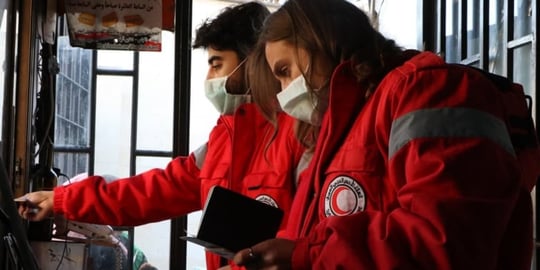
Grafikr Boosts Billable Utilization by 35% with Forecast

There are tons of reasons why people like to work with agencies. They bring an outside perspective, not to mention a depth of expertise that’s only possible when you have spent years defining your unique value proposition and niche. Ninety-nine times out of a hundred, their creative solutions will surpass what you are able to propose on your own.
It’s this unique creativity and energy that we love about agencies. And yet so many agencies find an inordinate amount of their time taken up by work that is not client-facing, that is not creative. Complex, admin-heavy project management tasks can end up consuming the team’s bandwidth. As a result, says Kiranan Luxmy, agency members can get drawn away from where their real priorities should lie: with delivering quality work to the client.
Kiranan is a founding member and the CEO of Grafikr, a Danish e-commerce agency with offices in Copenhagen and Randers. Established in 2016, Grafikr helps scale-up companies build out their customer journeys into the best, most compelling online experiences possible, encouraging customers to return time and again. As Denmark’s leading Shopify agency, they have a strong focus on excellence. It’s no wonder that they count many high-end and luxury lifestyle brands among their clients.
When people come to Grafikr, they come for quality and sleek results. And while delivery excellence requires strong project management, the ideal scenario is that this will just tick along in the background while you focus on delivering beautiful work. Nobody starts an agency because they love managing projects; people start agencies because they love creating great work for clients!
This was certainly apparent in the early days of Grafikr. Client satisfaction was absolutely front of mind. But project management is, after all, an entirely separate discipline to web development. The team simply did not have the experience, and nor indeed did they have the time to upskill in project management. And so, the way projects were managed became secondary to the job at hand.
“You can get away with that as a small team,” Kiranan reflects, “When we started out, our focus was entirely taken up by the products we were creating. We didn't focus on things like financial performance. We didn't focus on resource management. But now we’re 30 people, it’s a different story.”
The level of infrastructure and process that any organization needs - not just agencies or project-based businesses - is largely contingent on how big it is, and how much bigger it wants to get. Certain ways of working are scalable; others only work at a particular point in time. Non-scalable processes are liable to collapse under pressure. And even if the team manages to muddle along, constantly troubleshooting or looking for workarounds, serious operational issues can end up hiding in plain sight.
As Kiranan notes, putting off the decision to move to a scalable way of working ends up causing bigger problems down the line.
“At first we were using Podio, and that was fine when we were a small team. When we realized we needed resource management, we looked at Asana. But with Asana so much of the setup is manual. It was not clear how we could track time, or track our financial performance, or show budget in relation to projects.”
Implementing Asana as an imperfect in-between solution ended up creating its own issues. For a while, Grafikr made do without accurate resource availability and time tracking integrated into their project management workflow. But without the clear, integrated visibility over financials and resource capacity, their growing agency was facing profitability problems. They tried to build workarounds in Asana, but it became clear that this was an ineffective use of their time. It required too much building and development, when they weren’t even totally sure what they wanted to set up.
“Ultimately, our focus is to deliver a really great e-commerce service: we are experts in Shopify; we don’t want or necessarily have the skills to build our own project management system.”
With their eye on a sustainable, scalable future, Grafikr decided that it was time to hunt out an integrated project management solution that did it all. Something built by project management experts; a system that encourages best practice and pulls all the relevant data together to build a holistic picture of your projects - both those which are running, and those in the pipeline. Their search led them to Forecast.
And when they implemented Forecast, the effect was transformational. Finally, with all of their resource, project, and financial data in one place, the inefficiency culprits could be made clear.
“Forecast gave us the ability to look into all the numbers and find out what wasn’t working. In fact, it really encouraged us to slow down and focus on getting our numbers right before we made any more decisions on hiring new people.”
Growth really does have to be accompanied by intentionality and strategic thinking in order to be sustainable. But, of course, with limited time tracking ability in their previous tools, Grafikr had been unable to really get to grips with their resource utilization. Perhaps the key change that Forecast unlocked for Grafikr was, then, the ability to maximize what they already had.
“Improving our time tracking has been a really central thing for us,” notes Kiranan “Now that we have time tracking in a system that connects with everything we are working on, our billable utilization has gone from an average of 40% to closer to 75%. And our developers are now at 91% billable. It’s a huge change that has made Grafikr a lot more profitable. We are a much healthier company because of it.”
Not only did Forecast help Grafikr crack their resource utilization, the structure and functions of the platform helped bridge some of the gaps in Grafikr’s project management practice, such as reporting on project KPIs. The Forecast Customer Success team was able to dive into these functions with the Grafikr team, guiding them towards best practice, and ultimately stepping into a consultative role. According to Kiranan, it felt like a partnership that was focused on helping Grafikr occupy a place where growth would be more sustainable.
“The Customer Success team has given us a lot of inspiration on how to optimize the way we report on project status. It’s had a big impact on my everyday work.”
Forecast is part of Grafikr’s next chapter, giving them the tools to keep scaling and securing their place as Denmark’s premier Shopify experts. However, Kiranan believes that the Grafikr team could have saved themselves an enormous amount of stress during their first growth spurt if they had just bitten the bullet at that stage, and implemented a robust, scalable project management system like Forecast. For agencies that have the intention to grow, the value-add of Forecast can start much earlier in the process than you might expect. The data that Forecast surfaces can be instrumental in guiding growth strategy.
“The insights we have now with Forecast are something I would have loved to have had two years ago, when we were first really starting to grow. We were facing many problems without the data to understand how to fix them. But now we have Forecast, it has given us control. And, looking forwards, I think it is going to help us to scale. Based on resource availability, based on skills, Forecast will guide us to know when we need to recruit new people.”
For an agency so focused on leveraging tech to stay at the front of the e-commerce pack, it is no surprise that Grafikr is also excited for the future development of Forecast. Indeed, our commitment to “forge the future” was part of the central appeal that encouraged Grafikr to choose Forecast.
“Interesting new features are always being added. Advanced Analytics is going to give us so much more reporting power - my vision for the future of project management at Grafikr is that we spend more time discussing the data, actioning the data, rather than crunching numbers to get the data. Advanced Analytics is going to help us achieve that. And Nova Insights* is such an exciting idea - it’s like Forecast is asking ‘How can we make project managers even better at what they are already doing?’ by adding features that work independently in the background, adding value through AI.”
Forecast’s AI proposition - a major focus of our current development - stood out to Kiranan in particular. No other project management platform is doing anything quite like it. The potential for AI to alleviate the burden of repetitive administrative tasks is huge, and every procedural, non-creative task taken off the plate of agency minds translates into time that can be spent elsewhere.
“This is one of the main reasons we why chose Forecast,” Kiranan agrees, “I’m interested in the AI. I want people to spend as much of their time as possible talking to clients, not creating tasks and doing admin. No one really wants to spend their time doing things like that, anyway.”
Kiranan’s aspirations for a more automated project management future will no doubt ring true to other agency leaders. As a founding member, Kiranan has seen Grafikr grow and evolve over the years. He’s had a stint in every role in the company, from development, to project management, to business outreach. He understands better than most that time is of the essence. But now, Grafikr has the tool it needs to funnel as many hours as possible into valuable, client-facing work. Forecast is helping Grafikr take control and become the kind of agency it aspires to be.
“The agency mindset is always thinking how you can work smarter. And I think that’s one of the reasons why I appreciate the value of Forecast so much.”
*Nova Insights currently in beta; general availability expected in Q2 2022.

![How Finally increased Billable Rates by 130% with Forecast [Video]](jpg/finally_casestudy5e25.jpg)
